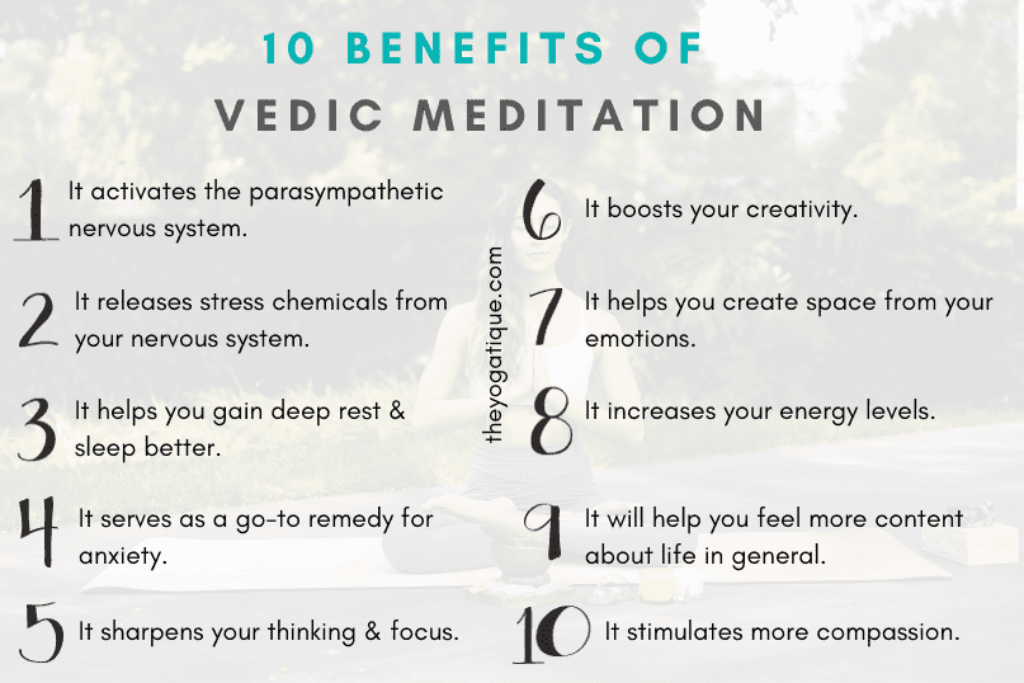Are you curious to explore the fascinating style of Vedic meditation? If you’ve been feeling called to learn this mantra-based meditation, this is for you. Read on as we explore the history, how-tos, and why people love this captivating practice!
With so many different styles of meditation out there, it’s only natural to want to experiment with different meditation techniques before you find which one works for you.
As a certified yoga teacher, I have studied various ways people meditate, and this is a huge area of interest and passion for me.
What are the benefits of Vedic meditation, and how can you get started?! Keep reading to learn all about this ancient meditation, which can be easily incorporated into our busy modern lives, and the mantras behind it.
Article content:
(Click any link below to jump directly to section)

BECOME A CERTIFIED MEDITATION TEACHER
Online Meditation Teacher Training Offers
- Affordability
- Flexibility
- Certification
- Lifetime access
⬇Click below to discover the best online meditation teacher trainings enrolling now⬇
What is Vedic meditation?
Vedic meditation is an ancient form of mantra meditation. It involves repeating a mantra. The mantra can be repeated mentally in your mind or out loud. The mantra serves as a vessel for the mind to travel to a quieter place within.
The philosophy of Vedic meditation teaches you that all you need to be happy is already within you. According to the Vedas, being happy is your natural state, the most natural of all. It is your birthright.
Experienced meditators report that what’s special about this type of meditation is that it’s effortless yet offers a deep and profound experience in a short amount of time.
What makes this style of meditation unique
Vedic meditation can be done anywhere as long as you can sit still and keep your eyes closed. Most other meditation techniques, like many Buddhist styles, require a quiet place. However, this is not the case for Vedic meditation.
Furthermore, Vedic meditators get a personalized mantra from their meditation teacher to meditate on. You don't choose the mantra yourself.
The effect of Vedic meditation on the mind and body is due to the vibrations of the sounds produced by repeating the mantra.
Vedic meditation history
Vedic meditation is one of the first meditation techniques ever developed. It is also one of the most ancient techniques of meditation, having originated from the 5,000-year-old ancient texts known as the Vedas.
10 benefits of Vedic meditation
Vedic meditation offers a multitude of benefits that extend beyond mere relaxation. Through regular practice, individuals can experience its profound positive benefits, including:
- Activation of the parasympathetic nervous system
- Releasing of stress chemicals accumulated in your nervous system
- Deeper rest & better sleep
- Lower anxiety levels
- Sharpenened thinking and enhanced focus
- Boosted creativity
- Detachment from emotions
- Increase in energy levels
- Increased feelings of contentment
- Stimulation of more compassion

How to start Vedic meditation as a beginner
First, you need to find a Vedic meditation teacher who will give you your mantras. You will get a mantra based on certain factors such as your lifestyle, location, age, and energetic balance. How to use your mantra:
- You will repeat this mantra in silence for 20 minutes two to three times each day.
One important thing beginner Vedic meditators should note is that a Vedic mantra is given in secrecy, and you should not disclose it to anybody.
The 5 steps of traditional Vedic meditation beginners should follow
Traditional Vedic meditation unfolds through a structured yet simple process designed to guide practitioners into a state of deep relaxation and heightened awareness. This technique revolves around five essential steps:
- Receiving a personalized mantra from a qualified instructor
- Finding a comfortable seated position
- Closing your eyes and settling your mind
- Silently repeating the mantra to transcend ordinary thoughts
- Returning to everyday consciousness with a refreshed and clear mind
1. Receiving a personalized mantra from a qualified instructor
If you don't have a teacher to assign a mantra to you, try some of the most famous bija mantras: OM, SO HUM, OM MANI PADME HUM.
2. Finding a comfortable seated position
To reap the full benefits of this meditation, you’ll want to be seated upright, ideally in a crossed-leg position, with your energy centers (chakras) aligned. Your spine should be straight, with your arms falling down on your thighs. I imagine you’ve seen or tried this common meditation position before.
3. Closing your eyes and settling your mind
It’s best to find a quiet space if you're new to meditation. Without distractions, you can close your eyes and quiet your mind. With eyes closed, scan your body from head to toe, toe to head. Do this for a couple of minutes before moving on to the mantra.
4. Silently repeating the mantra to transcend ordinary thoughts
Notice what it feels like to say your mantra. Notice what physical sensations are in your throat or any other body part. When you notice that your attention has drifted away from your meditation mantra, return to it. Allow any thoughts to be, and just come back. This is the basis of any meditation practice: the act of coming back.
5. Returning to everyday consciousness with a refreshed and clear mind
Feel your body. Feel the space around the body, the front, the back, the left, and the right side. Notice how you feel, how you are. How is your body now? How is your mind? And how does your breath feel? When it’s time, end your practice with a few deep breaths.
Why Veda mantras are so powerful
Vedic mantras come from Sanskrit. They are known as bija mantras, which means “seed”. Bija mantras, or the words within them, create certain vibrations in our body when they are produced. When we meditate on these words, the bija mantras activate the chakras.
Sanskrit is an extremely powerful language because it’s a vibrational language.
Takeaway
I hope you’ve gathered that learning Vedic meditation is easy and effortless. And with the many health benefits of Vedic meditation, like lower stress levels, higher mood, and more energy, there’s no reason not to try it. Enjoy!
If you still don’t have a set meditation or mindfulness practice or you wish to enliven your current one, this meditation technique might be the answer.
Some online yoga studios, online yoga teacher training programs, and brands that we write about may offer us a small percentage should you decide to purchase after reading our content. Thank you for enabling us to exist!









